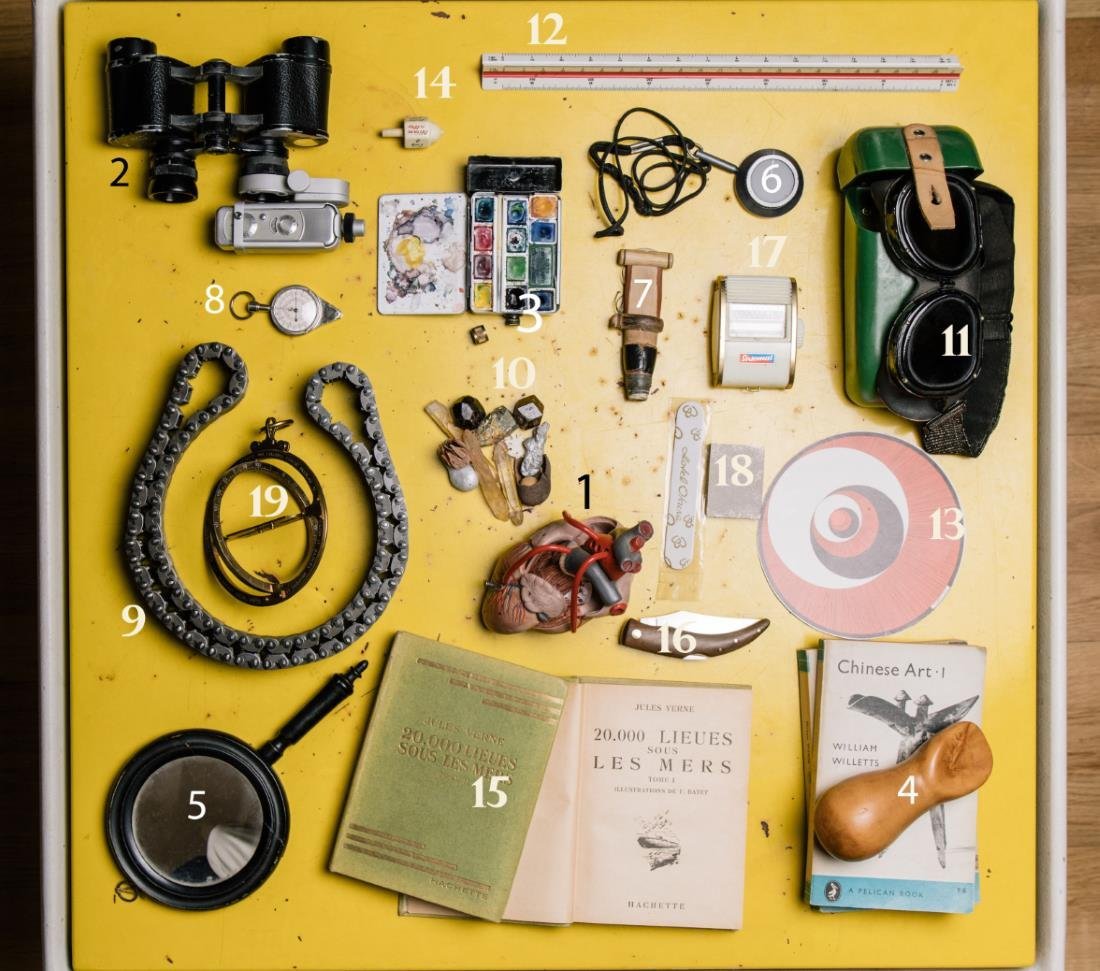
I love all types of “machines” that allow us to see the world differently. A mirror is also a machine. Since my childhood, they’ve fascinated me, I love the optical deformation. Show me someone who has never looked at their own deformed face on the back of a spoon.
heir watches truly do not resemble any others available, either aesthetically or in their functionality.
We can’t really detach the formal work of Martin Frei from the mechanical research executed by Felix Baumgartner. But where does Martin Frei’s personal inspiration come from? His watches sometimes appear to have come straight out of a strange science-fiction film.
What sort of imagination could they have been inspired by?
To allow us to understand this a little better, and just for us, Martin Frei has opened up his personal treasure box. At first sight, it’s just a mish-mash of flea-market junk, but on closer inspection, we start to get a grasp of the conceptual pathways that led to the creation of watches that are far from the ordinary.
A journey inspired by insatiable curiosity, by an immoderate taste for “tools that can allow us to see the world from another perspective”, by an ongoing sense of sensuality and by an ever-present taste for unusual encounters that dates back to his childhood.
Or, as Lautréamont said, the taste for what is “as beautiful as a sewing machine and an umbrella, meeting by chance on a dissecting table.”

1. A heart
“I was living in NY. I had met a girl and we decided to visit the flea market. I spied this heart and she offered to buy it for me. But over and above it being a sentimental memory, a heart is a machine, it’s our internal clock but without cogs. Evolution has developed this. It seems so simple to understand and yet it does an incredible job, unbelievable.”
2. Minox camera and binoculars
“I’ve always been fascinated by anything that enhances our senses. Pirates spy-glasses, telescopes and microscopes. To observe distances or close-up, here both are combined. The fabulous Minox, a true design masterpiece, thought out to the last detail by Walter Zapp in 1936 and, because I‘ve been hugely inspired by these, I’ve doubled them up with an old set of Zeiss binoculars. A real do-it-yourself spy kit."
3. Watercolours
“This is a little country box of watercolour paints. I still use these a lot.
I love their absolute simplicity, with their own little corked water container and the little brush as fine as a cats whisker. Total freedom!"
4. Wooden object
“This is the first thing I made at Art-School, made of hardwood, it has an incredibly delicate feel. I was inspired by a volcanic rock that I reproduced and enlarged. We could call it, a big cumbersome spoon."
5. Mirror
“I love all types of “machines” that allow us to see the world differently. A mirror is also a machine. Since my childhood, they’ve fascinated me, I love the optical deformation. Show me someone who has never looked at their own deformed face on the back of a spoon."
6. Contrast Glass
“This is a tool that allows us to view image contrasts, indispensible to all filmmakers. The day I bought it, I felt that I’d become a real filmmaker. I still make films, videos and artistic documentaries. For me, be able to escape from watch making, is as important as being part of it."
7. Duduk mouthpiece
“This is truly simple object that older people will already know. It’s the mouthpiece and reed of a Duduk, a sort of ancient Armenian oboe. A gipsy musician gave it to me during a tour in Armenia. He had made it himself, but it’s perfect! There’s even sticky tape on it. It has a kind-of warm - soft note."
8. Mechanical map measurer
“This has a little roller at the end. By pushing it along a road on a map, we precisely follow the route and the instrument indicates the distance travelled in relation to the scale. I always look for instruments that show us something. They’ve each got something different to teach us. Moreover, indicating time in a different manner gives us another perception of time."
9. Transmission drive chain
“This magnificent steel drive chain came from an abandoned industrial building in Zurich. They built enormous machines there. I went there and collected all sorts of pieces. I have love for all sorts of raw materials and this heavy but supple drive chain is an industrial masterpiece."
10. Crystals, sea-shells, cell-phone antennas
“The crystals have a geometrical order, the shells have fractal structures, the cell-phone antennas washed by the sea become like coral. The physical laws of nature create order.”
11/12/13/14/15/16/17/18/19.
In no particular order, but the list could go on and on: pilots goggles glasses - made in the USRR to observe atomic explosions / a scale- rule / a Duchamp disc / a six-sided spinning top / “20,000 leagues under the sea” by Jules Verne / a mechanical photographic cell / a penknife / nail file from the Okura Hotel Tokyo / a portable armillary sphere. ”
-

- The UR-T8 Reversible, the latest from Urwerk




















